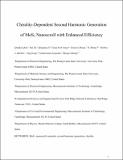| dc.contributor.author | Qian, Qingkai | |
| dc.contributor.author | Zu, Rui | |
| dc.contributor.author | Ji, Qingqing | |
| dc.contributor.author | Jung, Gang Seob | |
| dc.contributor.author | Zhang, Kunyan | |
| dc.contributor.author | Zhang, Ye | |
| dc.contributor.author | Buehler, Markus J | |
| dc.contributor.author | Kong, Jing | |
| dc.contributor.author | Gopalan, Venkatraman | |
| dc.contributor.author | Huang, Shengxi | |
| dc.date.accessioned | 2021-10-05T14:43:53Z | |
| dc.date.available | 2021-10-05T14:43:53Z | |
| dc.date.issued | 2020-09 | |
| dc.date.submitted | 2020-09 | |
| dc.identifier.uri | https://hdl.handle.net/1721.1/132719 | |
| dc.description.abstract | © 2020 American Chemical Society. Materials with high second harmonic generation (SHG) efficiency and reduced dimensions are favorable for integrated photonics and nonlinear optical applications. Here, we fabricate MoS2 nanoscrolls with different chiralities and study their SHG performances. As a 1D material, MoS2 nanoscroll shows reduced symmetry and strong chirality dependency in the polarization-resolved SHG characterizations. This SHG performance can be well explained by the superposition theory of second harmonic field of the nanoscroll walls. MoS2 nanoscrolls with certain chiralities and diameters in our experiment can have SHG intensity up to 95 times stronger than that of monolayer MoS2, and the full potential can still be further exploited. The same chirality-dependent SHG can be expected for nanoscrolls or nanotubes composed of other noncentrosymmetric 2D materials, such as WS2, WSe2, and hBN. The characterization and analysis results presented here can also be exploited as a nondestructive technique to determine the chiralities of these nanoscrolls and nanotubes. | en_US |
| dc.language.iso | en | |
| dc.publisher | American Chemical Society (ACS) | en_US |
| dc.relation.isversionof | 10.1021/ACSNANO.0C05189 | en_US |
| dc.rights | Creative Commons Attribution-Noncommercial-Share Alike | en_US |
| dc.rights.uri | http://creativecommons.org/licenses/by-nc-sa/4.0/ | en_US |
| dc.source | DOE repository | en_US |
| dc.title | Chirality-Dependent Second Harmonic Generation of MoS 2 Nanoscroll with Enhanced Efficiency | en_US |
| dc.type | Article | en_US |
| dc.identifier.citation | Qingkai Qian, Rui Zu, Qingqing Ji, Gang Seob Jung, Kunyan Zhang, Ye Zhang, Markus J. Buehler, Jing Kong, Venkatraman Gopalan, and Shengxi Huang, Chirality-Dependent Second Harmonic Generation of MoS2 Nanoscroll with Enhanced Efficiency, ACS Nano 2020 14 (10) | en_US |
| dc.contributor.department | Massachusetts Institute of Technology. Department of Electrical Engineering and Computer Science | |
| dc.contributor.department | Massachusetts Institute of Technology. Department of Civil and Environmental Engineering | |
| dc.relation.journal | ACS Nano | en_US |
| dc.eprint.version | Author's final manuscript | en_US |
| dc.type.uri | http://purl.org/eprint/type/JournalArticle | en_US |
| eprint.status | http://purl.org/eprint/status/PeerReviewed | en_US |
| dc.date.updated | 2021-10-05T12:52:11Z | |
| dspace.orderedauthors | Qian, Q; Zu, R; Ji, Q; Jung, GS; Zhang, K; Zhang, Y; Buehler, MJ; Kong, J; Gopalan, V; Huang, S | en_US |
| dspace.date.submission | 2021-10-05T12:52:13Z | |
| mit.journal.volume | 14 | en_US |
| mit.journal.issue | 10 | en_US |
| mit.license | OPEN_ACCESS_POLICY | |
| mit.metadata.status | Authority Work Needed | en_US |
